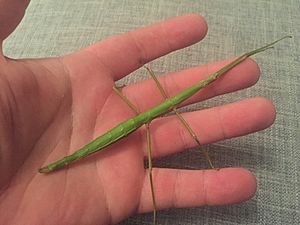Acanthoxyla inermis facts for kids
Quick facts for kids Acanthoxyla inermis |
|
|---|---|
 |
|
| An unarmed stick insect (Acanthoxyla inermis) seen in Wellington | |
| Scientific classification | |
| Synonyms | |
|
Acanthoxyla prasina Salmon, 1955 |
The unarmed stick insect, also known as Acanthoxyla inermis, is a fascinating insect. It was first described in 1955 by a scientist named John Tenison Salmon. This stick insect belongs to the group called Acanthoxyla and the larger family of Phasmatidae.
This amazing insect originally comes from New Zealand. However, it has also found a new home in Great Britain. It arrived there by accident, likely carried on timber. Now, it has a strong and stable population in Great Britain. It's even the longest insect ever seen there, and the most common stick insect to have settled on the island!
Contents
What Does It Look Like?
The unarmed stick insect has a long, thin body. It also has three pairs of thin, jointed legs. These features help it look just like a twig or a leaf. This helps it blend in with its surroundings.
These insects can look quite different from one another. Their bodies can be green, brown, or yellow. They can also have different textures. Some have smooth bodies, while others have small bumps or even spines. Adult unarmed stick insects can grow up to 10 centimeters (about 4 inches) long.
How It Stays Safe
Acanthoxyla inermis, like other stick insects, is a master of disguise. Its long, thin body is very hard to spot among real sticks and branches. This amazing camouflage helps it hide in plain sight from predators.
Besides looking like a twig, these stick insects also act like one. They sway their bodies gently, just like a branch moving in the breeze. This behavior makes their camouflage even more convincing.
Life Stages
Stick insects grow through a process called incomplete metamorphosis. This means they grow by shedding their outer skin, called an exoskeleton, many times. This process is called moulting.
A stick insect's life has four main stages:
- Egg: Adult females lay their eggs (called ova). They often drop them to the ground or place them in a safe spot. These eggs are very tough. They can survive falling from a height and even cold winter weather. The egg stage can last from just two weeks to over 18 months!
- Nymph: After hatching, tiny nymphs quickly climb plants to find food. They eat leaves and hide in the safety of the plant. Nymphs moult several times as they grow. Each moult allows them to get bigger. If a nymph loses a leg, it can even regrow it during a moult! Nymphs often eat their old skin after moulting.
- Sub-adult: This is the final moult before the insect becomes a full adult. It's a short but important part of their life.
- Adult: Adult stick insects usually live for about six months to a year. During this time, they focus on eating and reproducing. A. inermis spends most of its adult life on trees, munching on leaves and staying safe.
How They Reproduce
The unarmed stick insect has a very special way of reproducing. From what scientists have seen, A. inermis reproduces entirely without a male. This process is called parthenogenesis. It means the female can create baby stick insects all by herself!
Because they don't need a male, these stick insects can start new populations from just one female. This is how they spread to Great Britain. Timber carrying a single female likely arrived in the 1920s. Since then, the unarmed stick insect has become the most common stick insect in Great Britain. Great Britain doesn't have any native phasmatodea species, but several have arrived in similar ways.
This type of reproduction means all the offspring are clones of the mother. This can make them more vulnerable to big environmental changes. However, the Acanthoxyla group itself came from different species mixing. This means individual unarmed stick insects still have a good variety of genetic information.
In 2016, a single male A. inermis was seen in the United Kingdom. This is very rare! It can happen if a special change occurs during egg production.
Clever Behavior
Stick insects are famous for how well they blend in. Besides looking like twigs, they also move like them. They sway their bodies when they walk and even when they are still. People used to think this only helped their camouflage.
More recently, scientists have suggested another reason. This swaying might also help the stick insect see better. It could help them tell the difference between branches that move with them and other things that are not attached to their plant.
In Maori Culture
Stick insects are mentioned in some Maori legends. Like all insects, they are seen as children of Tane, the god of forests and birds. They are to be respected.
In Maori culture, stick insects could mean different things:
- If a stick insect landed on a woman, it was sometimes seen as a sign that she was pregnant.
- Some stories said that if a stick insect was present, a place was not good for a garden.
- Other tales suggested that if a stick insect landed on someone, it meant they had entered a sacred place.

